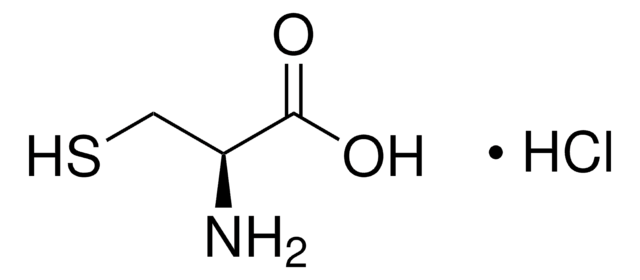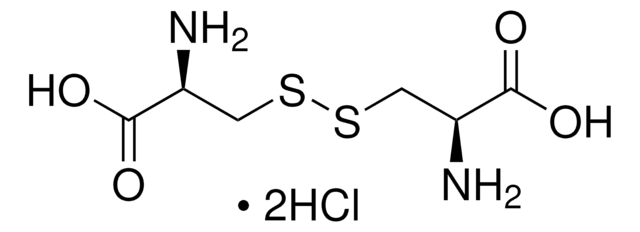C7477
L-Cysteine hydrochloride
≥98.0%, suitable for cell culture, BioReagent, non-animal source
Synonym(s):
(2R)-2-Amino-3-sulfanylpropanoic acid hydrochloride
About This Item
Recommended Products
Product Name
L-Cysteine hydrochloride, anhydrous, from non-animal source, BioReagent, suitable for cell culture, ≥98.0%
biological source
non-animal source
grade
anhydrous
product line
BioReagent
Assay
≥98.0%
form
powder or crystals
technique(s)
cell culture | mammalian: suitable
impurities
endotoxin, tested
color
white to off-white
mp
174.1-174.7 °C
solubility
H2O: 50 mg/mL
application(s)
peptide synthesis
SMILES string
Cl[H].N[C@@H](CS)C(O)=O
InChI
1S/C3H7NO2S.ClH/c4-2(1-7)3(5)6;/h2,7H,1,4H2,(H,5,6);1H/t2-;/m0./s1
InChI key
IFQSXNOEEPCSLW-DKWTVANSSA-N
Looking for similar products? Visit Product Comparison Guide
Application
Biochem/physiol Actions
Storage Class Code
11 - Combustible Solids
WGK
WGK 1
Flash Point(F)
Not applicable
Flash Point(C)
Not applicable
Personal Protective Equipment
Choose from one of the most recent versions:
Already Own This Product?
Find documentation for the products that you have recently purchased in the Document Library.
Customers Also Viewed
Our team of scientists has experience in all areas of research including Life Science, Material Science, Chemical Synthesis, Chromatography, Analytical and many others.
Contact Technical Service



